Saffron risotto or risotto alla Milanese is a rich and flavorful classic risotto that highlights the perfect flavor combination of earthy saffron with luscious fat and salty cheese.

Many years ago my husband had a business trip in Piedmont and invited me to accompany him. We spent a week in Turin, venturing often out of the city and into the Piedmontese countryside for various culinary experiences.
A highlight of the week was when we were invited to a private 12 course dinner at a winery where we had an exceptional meal capped off with the most singular and exquisite panna cotta we've ever tasted.
A panna cotta so good we still talk about it to this day, taking turns remarking wistfully how it broke us from ever enjoying 'normal panna cotta' again.
I digress...
Another highlight was a weekend spent in Milan, where we casually ambled around the canals in the Navigli district, taking turns directing one another across one bridge then the next, from one bank to another.
Eventually we wandered into a restaurant, the name of which is long-forgotten, but where we first tasted our first ever risotto alla Milanese.
Much like the panna cotta, it was revelatory. Earthy saffron, salty parmesan, sweet onion, beautiful luscious fat from bone marrow and butter.
It's no wonder this risotto is considered a classic.
When I got back to the US I quickly tried to capture the flavor with a most-American rendition - saffron mac and cheese.
But there's a reason saffron risotto is a classic and I've finally gotten around to shooting and sharing the recipe.
It's my hope that the taste of this risotto leaves as indelible a mark on your senses and memories as it did to mine.
Ingredients
The ingredients here are for a very traditional rendition of saffron risotto. The recipe is adapted from The Silver Spoon cookbook, which is considered a very authoritative source for authentic Italian recipes.
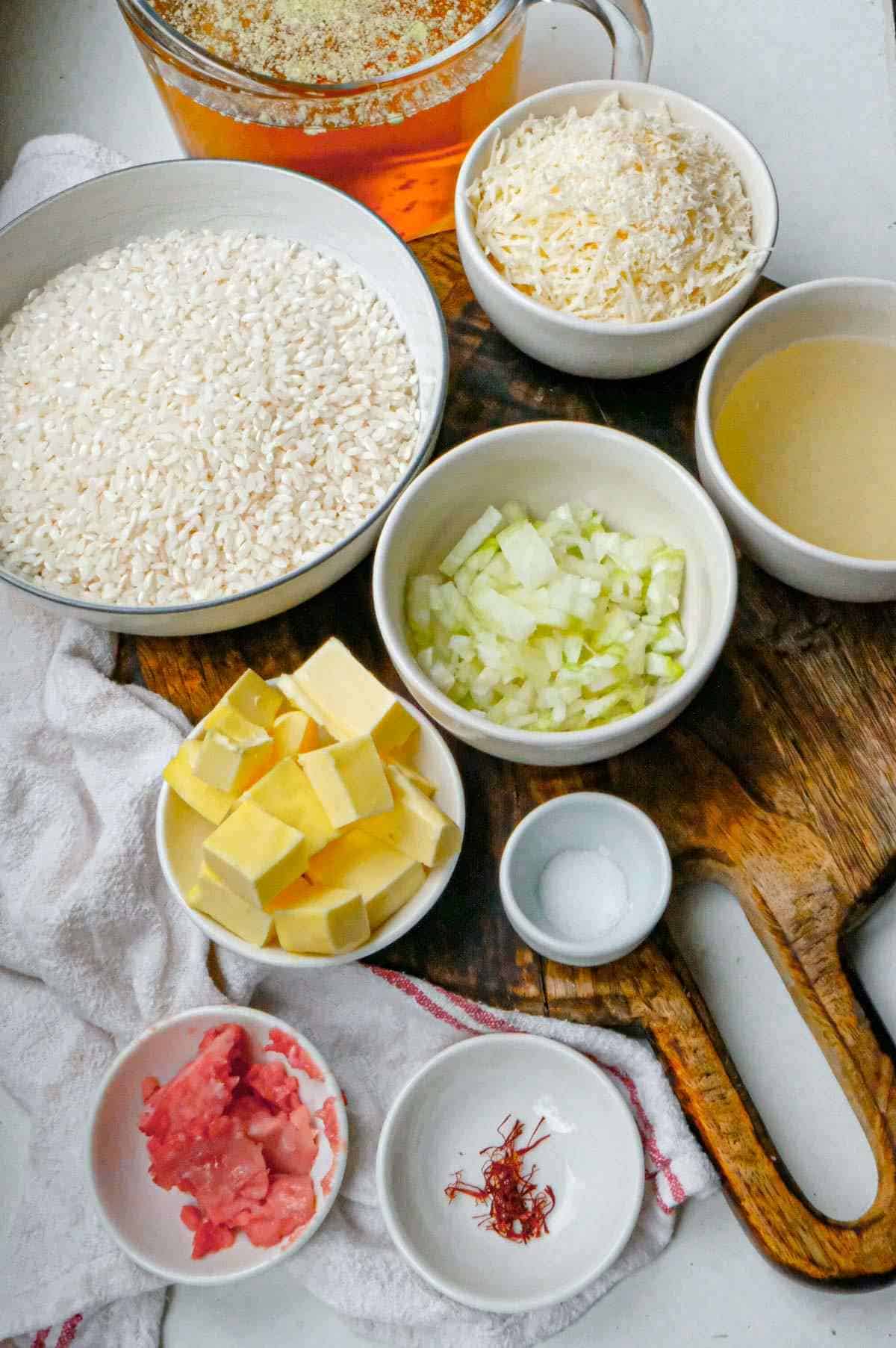
Short grain rice: The ideal varieties of rice for risotto are Arborio or carnaroli which are short grain white rice that are very high in starch. The starch is what makes the risotto magic happen. There are other varieties in other culinary traditions that are very similar though so feel free to substitute. Just make sure you use a short grain rice.
Yellow onion: Finely diced yellow onion adds sweetness. You can also substitute white onion or shallot. Red onion could affect the color of the risotto and dull a bit of that golden hue.
Butter: Butter is used to sauté the onion and lightly toast the rice before adding liquid. It provides the lubrication needed for the right cooking reactions to happen (i.e. caramelization) and it also adds flavor.
Bone marrow: Yes, bone marrow! What a beautiful and luxurious addition. Bone marrow adds extra richness and flavor. If you are making this saffron risotto in the classic pairing with ossobuco, an easy way to source bone marrow is to scoop a few tablespoons right out of the ossobuco. Otherwise your best bet is to check out your local specialty butcher. If you can't find bone marrow then you can just omit it from the recipe.
Beef stock: Low sodium is best since it allows you to more carefully calibrate the seasoning to your taste. If you aren't using low sodium stock, then don't add any additional salt until the end. Taste as you go and if it starts getting too salty, use water or another low sodium stock instead. Keep in mind parmesan also goes in at the end, and that adds more salt as well.
White wine: Dry white wine brings flavor and complexity to the risotto.
Parmesan cheese: Parmesan cheese is used to finish the dish and adds a salty, umami high note that contrasts with the earthy base of the saffron.
Saffron: Since saffron is the star of the show here, you should try to use a high quality saffron. There's a lot of cheap saffron on the market these days but if you look closely it's pretty easy to tell the difference based on look alone. Quality saffron is made up of thin, trumpet shaped filaments that are a deep, vibrant red and have a powdery finish. Quality saffron smells and tastes earthy and mellow. Poor quality or fake saffron looks like yellowish or orange bits of straw and smells sweet.
Salt: There are already a few salty ingredients that go into the risotto. Be sure to adjust the salt accordingly if you aren't using low sodium beef stock. Likewise if you tend to season on the less-salty side of things, then I suggest waiting until the very end to add salt.
Instructions for making Risotto alla Milanese
You probably already know that risotto requires a certain technique and method. This is true, but I would humbly suggest not to overthink it.
I know some people are adamant that risotto is unfailingly precise, requiring a carefully calibrated approach spanning many hours of continuous stirring.
In fact, the original recipe in the Silver Spoon cookbook calls for the liquid be added to the risotto so slowly that it takes over four hours to make the risotto!
That is not this recipe. This recipe is a middle of the road approach which had the risotto finished in about 45 minutes.
You still get the unctuous creamy magic that happens when the starches and liquids emulsify, but you aren't going to be standing over the stove stirring your pot for hours. Who has time for that nowadays anyway?
From a technical standpoint, two processes are taking place when you make risotto which are responsible for that 'risotto magic':
- The repeated process of drying out, lightly searing, and adding liquid again - adds layers and layers of caramelized flavor.
- The starches from the rice are emulsifying with the liquid to create a creamy sauce that bathes the rice;
With that in mind, the process should look something like this:
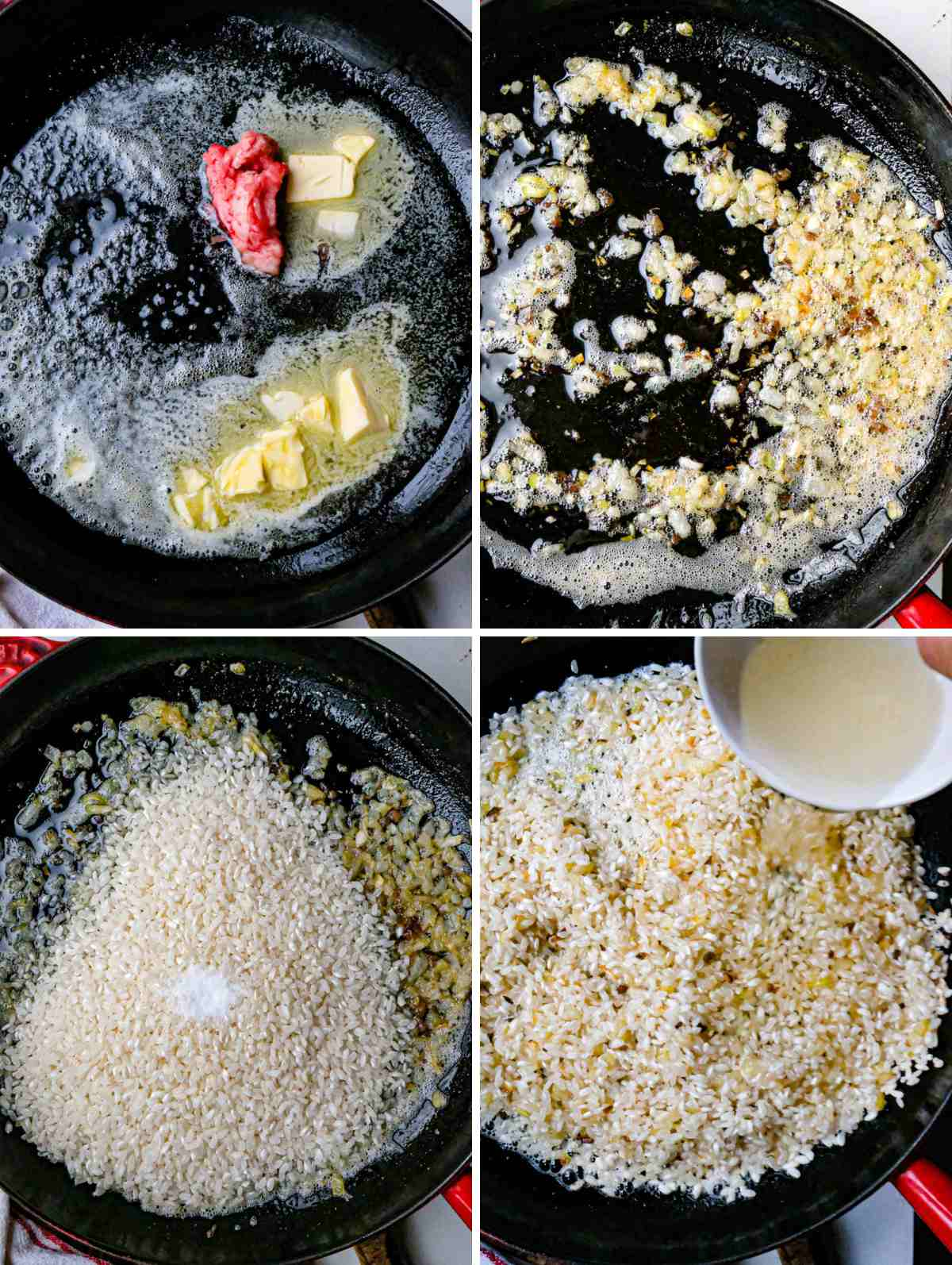
Put the beef stock in a small saucepan to heat and keep it over low heat while you make the risotto.
On another burner set out a pan for the risotto. Good options are stainless steel or cast iron saucepan or deep skillet. I would recommend against non-stick, as the properties actually prevent the caramelization that you want to achieve.
Melt butter and bone marrow over medium-high heat. Sauté the onion until soft, can be slightly golden but not brown.
Add the rice and salt (see note on salt above). Toast the rice a bit until it's coated all over with fat and the onions are evenly distributed.
Now the fun starts - adding the liquid.
Getting maximum flavor from risotto has two stages:
During the first stage, you add tiny bits of liquid at a time and allow the rice to stick and slightly caramelize.
This process creates new flavor compounds, including those umami packed molecules that come from the Maillard reaction.
At this point the pan should be hot enough that when you add the wine, it sizzles and a big plume of steam forms immediately.
Add more liquid only when the risotto has begun to stick together and stick slightly to the pan. Yes, we want it to stick in this case. But not to stick so much that it burns. Just enough that you can see its simmering in contact with the pan.
Then a little more liquid. Whenever you add liquid it should sizzle vigorously and release a plume of steam.
You really need to keep it moving constantly - the parts of the risotto in the inside of the clumps will still have unabsorbed liquid so when you move the risotto around all the surface area has a chance to be cooked and to absorb the liquid and let the starches begin to caramelize
Eventually there will be a tipping point where the risotto is wet enough that it no longer sticks or caramelizes. At this point the second stage starts.
The second stage is emulsification of the starches. Emulsification is creating a suspension of solids in liquids - in this case starch molecules in that flavorsome liquid gold of bone marrow, butter, white wine and beef stock.
Use a half cup measure to add a half cup of the hot beef stock. Cook the risotto over medium-low. Stir frequently. Keep adding the beef stock until you've added it all.
This should take about 40 minutes (but you can also lower the heat and do it even slower if you want to follow the more traditional method).
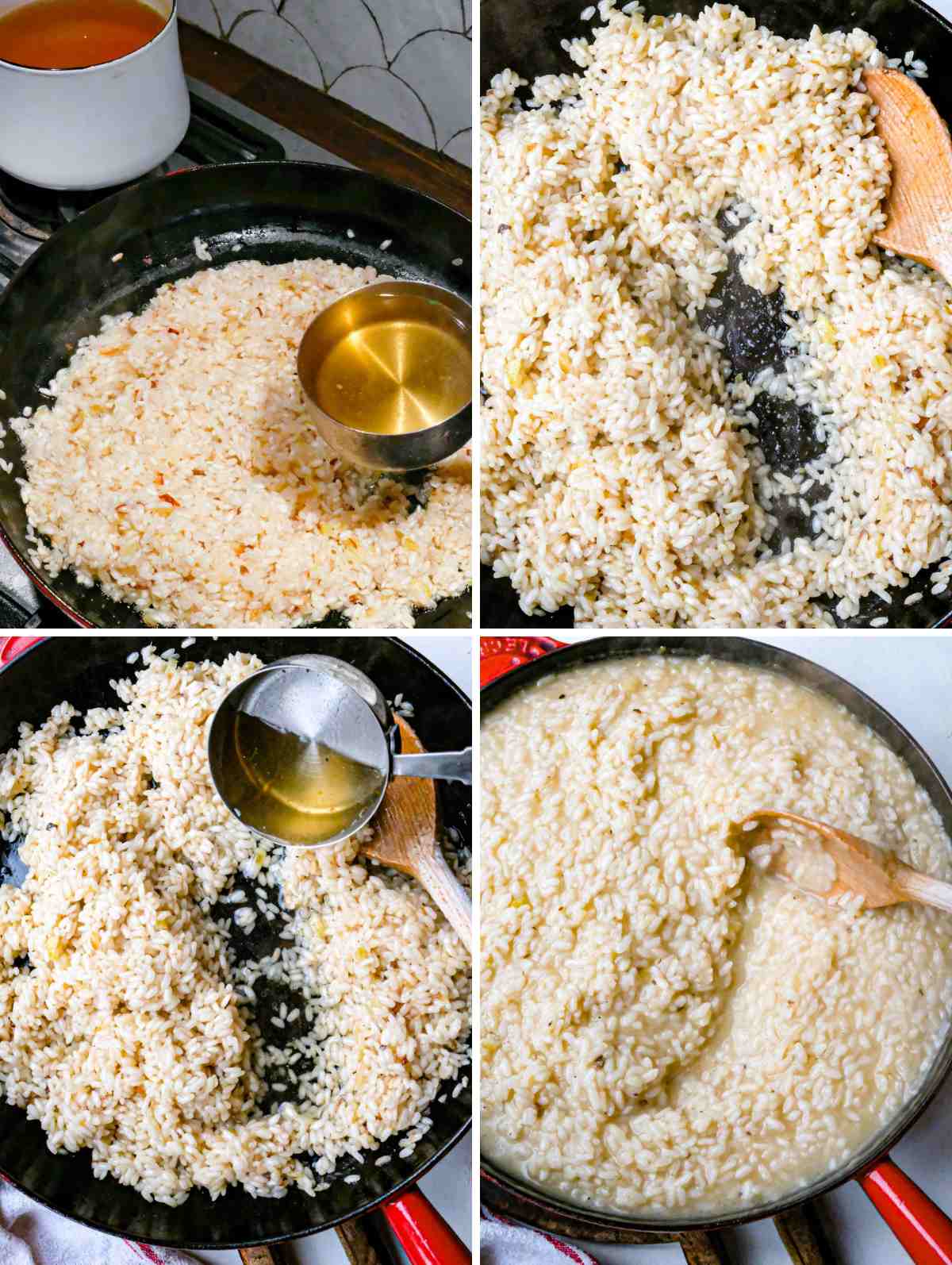
At the end the risotto should look soupy.
Not just wet, but truly soupy. Trust me on this. The parmesan will add a bit of bulk and then with the heat off, the starches in the sauce will gel, the fat will solidify and the whole thing will firm up.
So if you want to be sure to achieve that beautiful, loose texture that so characterizes a good risotto (and differentiates it from a more simple pilaf) then finish it soupy. You can see what I mean in the photos below.

Once the risotto is cooked. Taste to make sure the grains are cooked (there shouldn't be any hard grit in the middle).
Finish with the saffron (soaked in a bit of water), more butter, and the parmesan.
Serving Suggestion
The most classic pairing for saffron risotto is ossobuco alla Milanese (Milanese style slow braised veal shanks) and gremolata, a fresh mix of parsley, lemon and garlic, which offers an acidic counterpoint to the richness of the risotto and meat and really makes the whole combination pop.
Of course you don't have to stick to the classic pairing and can try other combinations like:

Related
Looking for more like this? Try these:
Recipe
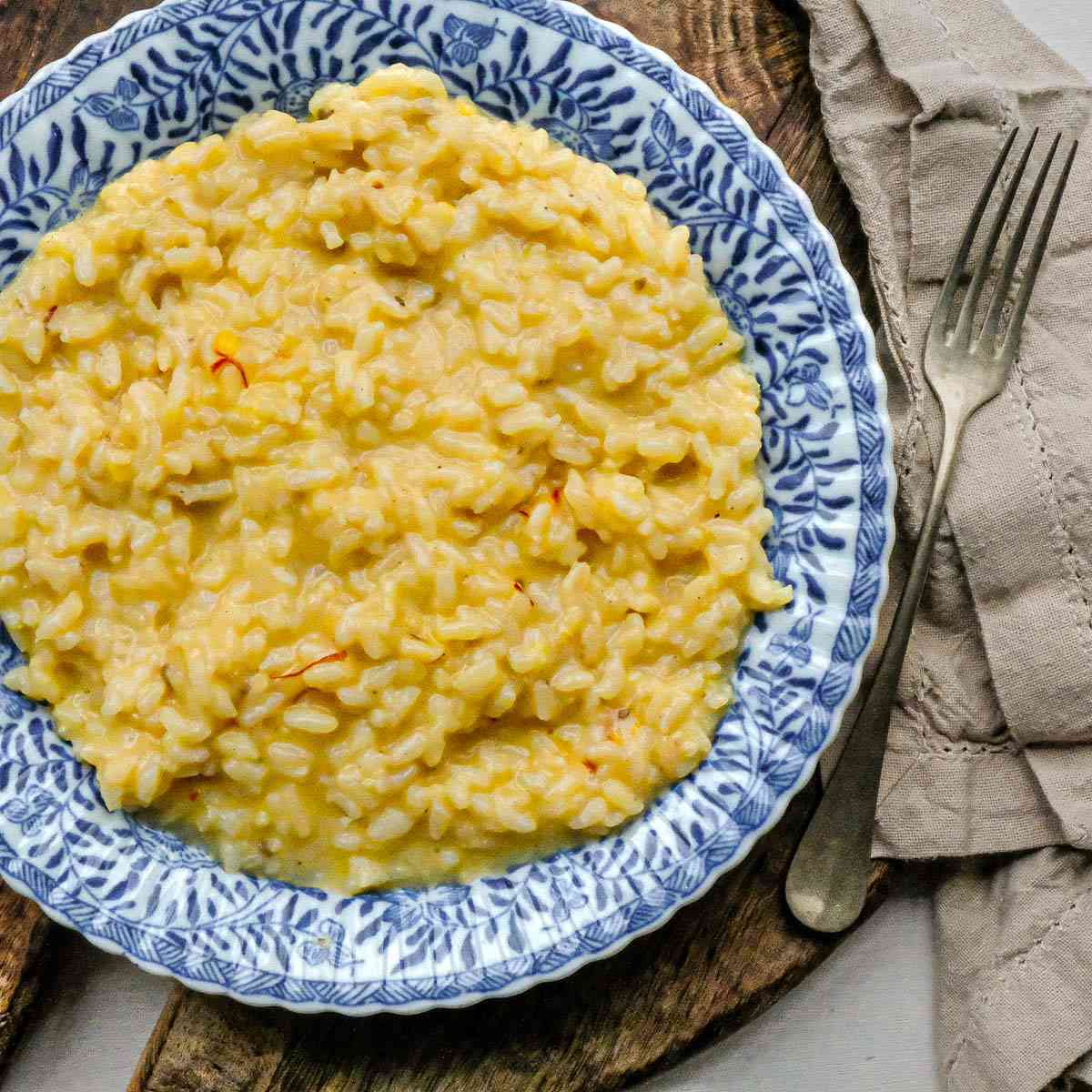
Saffron Risotto (Risotto alla Milanese)
Equipment
- 1 saucepan at least 2 liter / 2 quart capacity
- 1 large sauté pan at least 4 liter / 4 quart capacity
- half cup measure or ladle
Ingredients
- 385 grams Arborio rice About 2 cups
- 1 yellow onion finely diced
- 20 grams bone marrow about 2-3 tablespoons
- 80 grams butter about 6 tablespoons, divided
- 0.5 cup dry white wine
- 2 litres low sodium beef stock about half a gallon
- 80 grams parmesan cheese about a cup, grated
- 0.5 teaspoon saffron threads
- 1 teaspoons salt less or more to taste
Instructions
- Put the saffron threads in a small bowl with 2 tablespoons of warm water and set aside.
- Put the beef stock in a saucepan and heat over medium until hot then reduce heat and hold warm.
- Heat a large sauté pan over medium-high heat. Melt half the butter and all of the bone marrow in it.
- Add the onion and sauté until reduced and just slightly golden.
- Add the rice and a teaspoon of salt. Toast the rice, stirring all the while, until it is fully coated with fat and the onion is evenly distributed throughout.
- Add the white wine and cook until the liquid fully absorbs and the rice begins to stick to the pan. Allow the rice to stick and lightly brown before adding more liquid.
- At first, add the hot beef stock one quarter cup at a time, again allowing the rice to fully absorb the liquid and start to lightly stick to the pan as it forms that caramelized layer. Continue stirring frequently.
- Eventually there will be so much liquid that the rice won't stick anymore. At this stage you can start adding a half cup of stock at a time. Stir frequently to emulsify the starches (agitation helps the sauciness form).
- Once all the beef stock has been fully added the mixture should be soupy as shown in the photos. If it's not, add more stock.
- When the rice is cooked and the risotto is the right consistency, turn off the heat. Gently whisk in the saffron, remaining butter, and parmesan cheese.
- Taste and adjust the salt to your liking. You may need to add half a teaspoon to a teaspoon more.



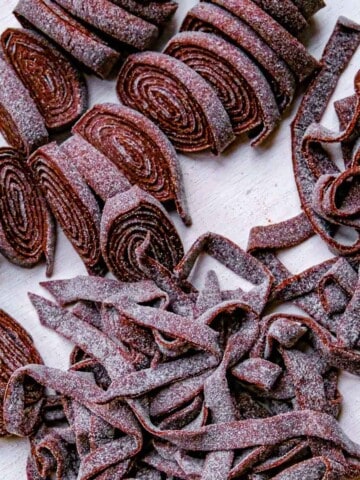



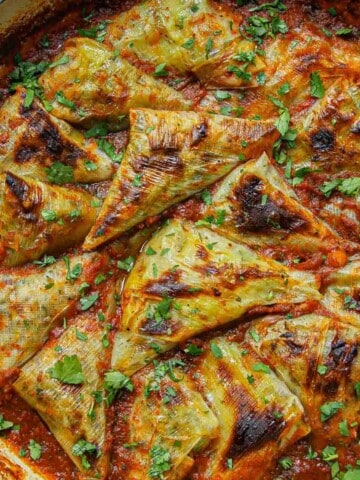

Comments
No Comments